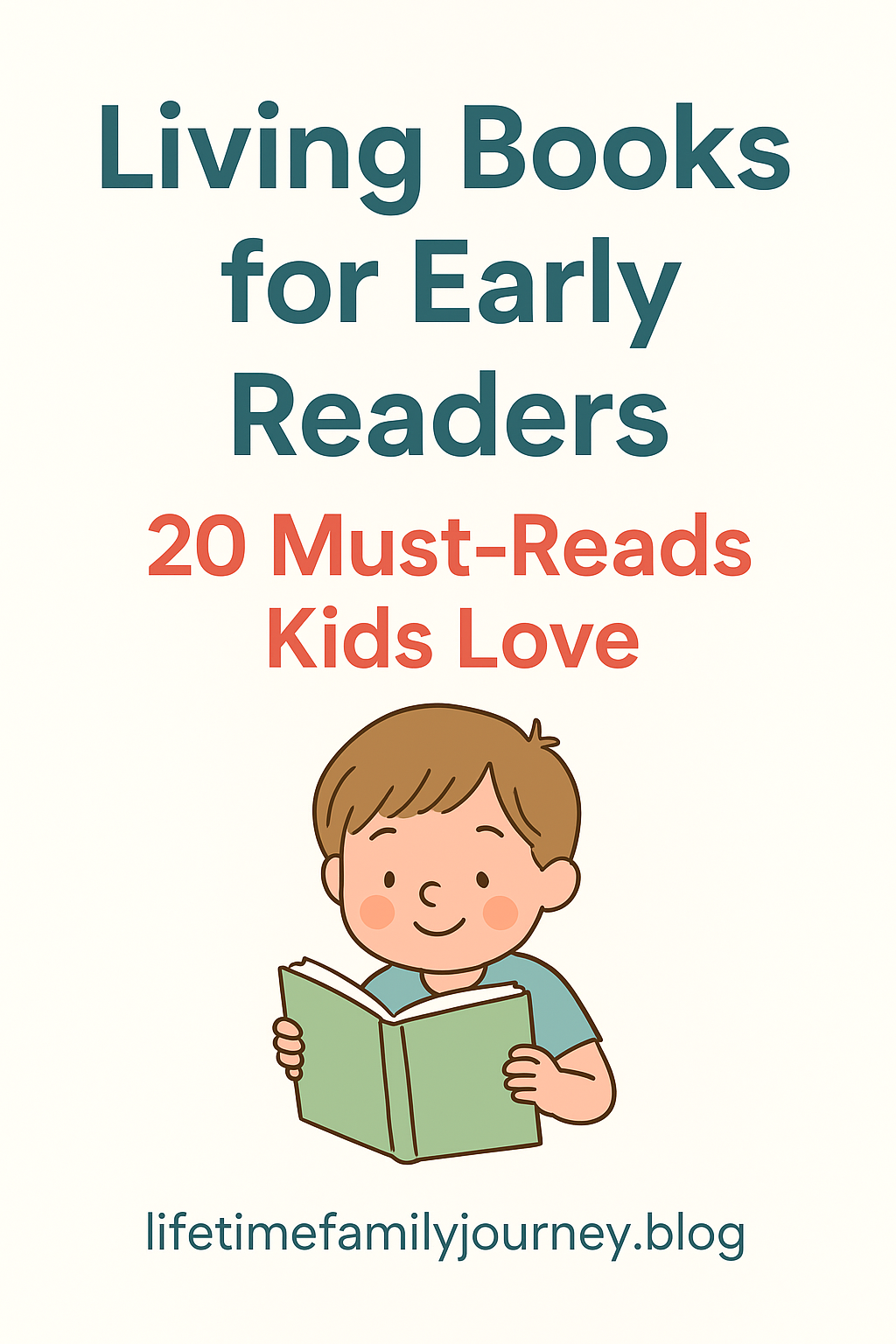Living Books for Early Readers: 20 Must-Reads Kids Love
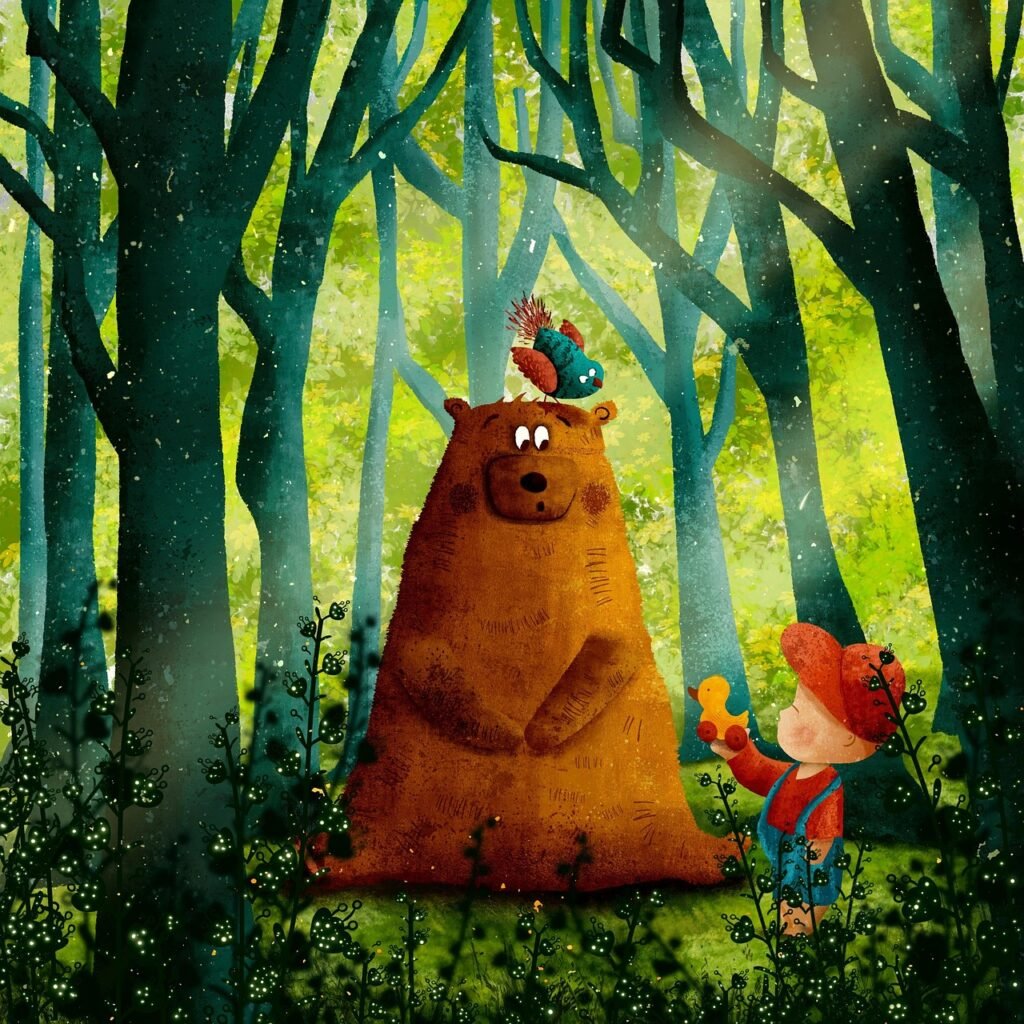
Living books for early readers transform reluctant listeners into eager story enthusiasts who beg for “just one more chapter.” I discovered this magical shift during our family reading time when my youngest was five. There I was, reading My Father’s Dragon while our golden retriever lay at my feet, ears perked up like she was following every word. Meanwhile, my six-year-old was doing gymnastics across the living room. The dog proved to be a better audience.
But here’s what I learned after fifteen years of homeschooling six children: not all books can compete with a cartwheel. Some books feel like homework disguised as stories. Others grab kids by the imagination and refuse to let go, creating memories that last long after bedtime ends.
The secret lies in choosing authentic living books for early readers—stories that breathe life into learning and make even the wiggliest kids settle down naturally. These aren’t just any chapter books or beginner readers. They’re carefully crafted narratives by passionate authors who respect children’s intelligence while meeting them exactly where they are developmentally.
After testing hundreds of books with my own children and countless homeschool families, I’ve identified 20 proven favorites that consistently capture young imaginations. These living books for early readers work across different personality types, learning styles, and attention spans. I’m organizing them by age and subject, plus sharing a rotation system that prevents overwhelm while ensuring delightful variety.

You’ll also get a free printable tracker that makes implementing living books for early readers ridiculously simple, even for the busiest families juggling multiple children and packed schedules.
What Makes Living Books for Early Readers Different from Everything Else
Quality literature for young children represents a complete departure from the fragmented, skills-based approach that dominates most educational materials. Instead of drilling isolated phonics rules or vocabulary lists, living books for early readers present rich language naturally embedded in compelling stories that children actually want to hear repeatedly.
Charlotte Mason, the brilliant British educator who coined the term “living books,” believed children deserved to feast on living ideas rather than the dry facts that fill most textbooks. Numerous schools and homeschools alike consistently support her understanding that children learn more effectively from passionate authors who bring genuine vitality to their subjects.

Consider the difference in approach. A traditional textbook states: “Spiders are arachnids with eight legs that spin webs to catch prey.” End of lesson. But E.B. White shows us Charlotte spinning her web with purpose, weaving words like “TERRIFIC” and “RADIANT” while teaching profound lessons about friendship, sacrifice, and the meaning of life itself.
One approach delivers forgettable facts. The other creates unforgettable experiences that shape character while building vocabulary, comprehension, and genuine love for literature. That’s the fundamental power of authentic living books for early readers.
🎯 Quality literature focuses on complete stories rather than fragmented skills. Children absorb language patterns, vocabulary, and comprehension strategies naturally through meaningful narrative context instead of isolated drills.
📚 They use rich, beautiful language that expands minds organically. Kids encounter sophisticated words like “salutations,” “humble,” and “versatile” in contexts that make meanings crystal clear and memorable.
🧠 They integrate multiple subjects seamlessly within single stories. Geography, history, science, and character development weave together naturally without feeling forced or compartmentalized.
❤️ They create positive emotional associations with learning. Children develop genuine affection for books when stories touch their hearts and spark their imaginations.
The magic in living books for early readers isn’t found in flashy graphics, interactive widgets, or gimmicky formats. It’s discovered in authentic language crafted by authors who love their subjects and respect their young audience. Parents seeking quality literature have embraced this approach for decades because children remember beloved stories long after worksheets and textbook facts fade from memory.
Less encyclopedia, more “please don’t stop reading!” That’s the essential difference between educational twaddle and literature that truly educates.
Why Living Books for Early Readers Consistently Outperform Traditional Methods
The evidence overwhelmingly demonstrates that living books for early readers create deeper, more lasting learning experiences than conventional educational approaches. Here’s exactly why this method works so reliably across different families, learning styles, and educational contexts.
✅ They build sophisticated vocabulary naturally and permanently. Children absorb rich language without conscious effort or resistance. When my son started using words like “resourceful” and “ingenious” after we read The Boxcar Children, I witnessed firsthand how living books for early readers develop vocabulary through meaningful context. These words stuck because they were embedded in story rather than memorized from lists.
💡 They develop focused listening skills and naturally extend attention spans. Even children with attention challenges settle into compelling narratives that capture their imaginations. I’ve watched my ADHD daughter sit motionless through entire chapters of Charlotte’s Web—something that never occurred with phonics workbooks or traditional readers that fragment learning into boring skill segments.
🧠 They teach comprehension and narration organically through story engagement. After experiencing living books for early readers, children naturally want to retell what happened, discuss favorite parts, and make connections to their own lives. This is oral narration—a powerful learning tool that develops automatically when children genuinely engage with compelling books.
The American Academy of Pediatrics strongly emphasizes that reading regularly with young children strengthens parent-child relationships during critical developmental stages while building language and literacy foundations that benefit children throughout their entire educational journey. This research validates what families using living books for early readers have experienced for generations.
🎭 They inspire imagination and creative play that extends far beyond reading time. Unlike worksheets that end when pages are completed, compelling stories continue living in children’s minds through pretend play, artwork, and endless questions about the wider world. Great living books for early readers spark creativity that enriches children’s entire experience of learning and discovery.
📊 They integrate academic subjects naturally across disciplines. When children follow Karana’s survival journey in Island of the Blue Dolphins, they simultaneously absorb geography, history, biology, problem-solving strategies, and character development. Quality literature excels at this seamless integration that mirrors how children naturally process information in real life.
🏆 Most importantly, they create joyful associations with books and learning. Perhaps the most significant advantage of living books for early readers is their power to help children view books as treasured friends rather than educational assignments. This foundational attitude determines whether children become lifelong learners who read for pleasure or reluctant students who abandon books after completing required schoolwork.
🎯 They respect children’s intelligence while meeting developmental needs. Quality living books for early readers never talk down to young readers or oversimplify complex ideas. Instead, they present sophisticated concepts through accessible stories that honor children’s capacity for deep thinking and emotional understanding.
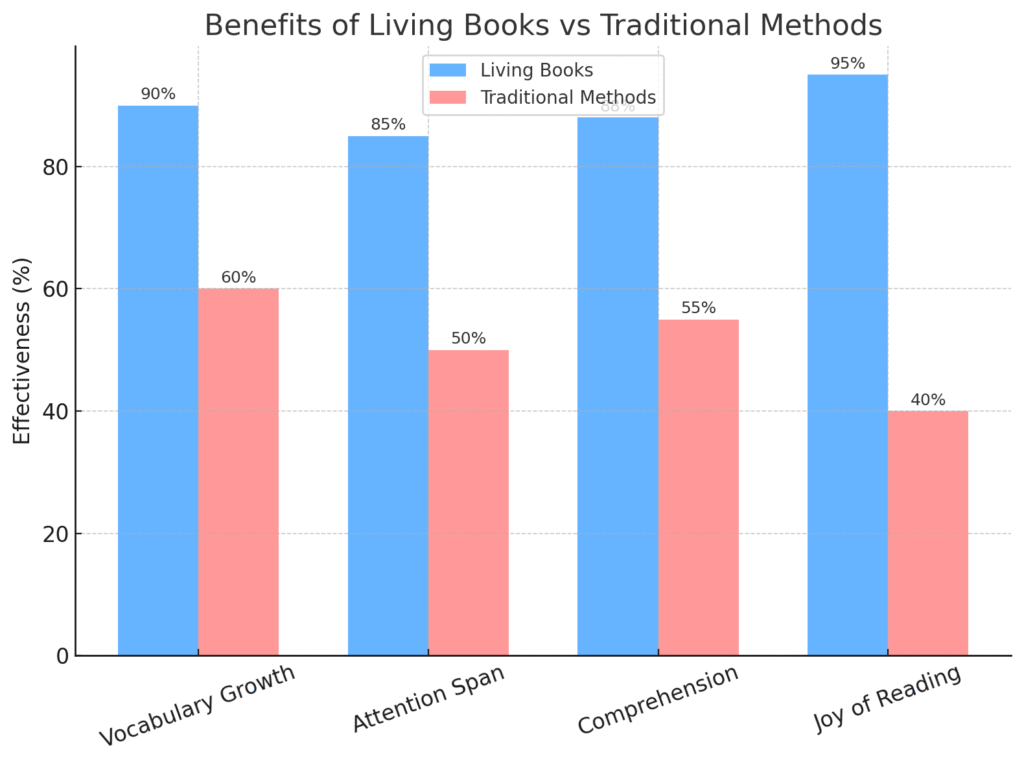
When Brayden was seven, he spent hours after our reading sessions acting out scenes from Mr. Popper’s Penguins, complete with makeshift penguin costumes and elaborate Antarctic adventures. He wasn’t just entertained—he was actively processing, remembering, and making the story completely his own through creative play. That’s exactly what the best books for kids accomplish, and it perfectly illustrates why living books for early readers create such profound and lasting impact on developing minds and hearts.
Essential Foundation Collection: Ages 5-7
These carefully selected living books for early readers have earned their reputation through decades of delighting children while building crucial literacy foundations. Each book features manageable chapters, engaging illustrations, and exactly the right balance of adventure and accessibility for developing listeners.
The brilliance of starting with this collection lies in their proven track record of success. These aren’t trendy titles that disappear after brief popularity—they’re time-tested classics that continue captivating new generations while providing solid educational value through compelling storytelling.
🐲 My Father’s Dragon by Ruth Stiles Gannett

Elmer Elevator’s creative rescue mission to save a captive baby dragon exemplifies everything that makes living books for early readers so powerfully effective. Short, perfectly-paced chapters make it ideal for bedtime reading, while children delight in Elmer’s ingenious problem-solving using everyday objects like chewing gum, hair ribbons, and lollipops. This Newbery Honor book demonstrates how adventure, heart, and precisely-calibrated reading level combine to create literary magic that lasts.
🏠 The Boxcar Children (Book 1) by Gertrude Chandler Warner

Four orphaned siblings transform an abandoned railroad car into their cozy home, proving that resourcefulness and family loyalty matter infinitely more than material possessions. The independence theme resonates deeply with children who crave grown-up responsibilities and decision-making opportunities. This beloved classic shows children consistently connecting with Henry, Jessie, Violet, and Benny’s determination to stay together against all odds.
🐧 Mr. Popper’s Penguins by Richard Atwater
House painter Thomas Popper inherits Antarctic penguins and transforms his quiet home into a chaotic wonderland of ice, fish, and feathered mischief. The multi-layered humor appeals to both children and adults—silly enough to provoke giggles but clever enough that parents won’t lose their sanity during repeated readings, a crucial consideration when choosing sustainable books for long-term family enjoyment.
🧸 The Velveteen Rabbit by Margery Williams
This profound yet completely accessible classic explores the deep question of what makes something—or someone—genuinely real through love, relationship, and time. The emotional sophistication might surprise parents, but children consistently handle big feelings and complex ideas better than adults often assume. It provides powerful evidence that living books for early readers never need to be artificially dumbed down or oversimplified to remain perfectly accessible to young minds.
🐦 The Burgess Bird Book for Children by Thornton Burgess
Master storyteller Thornton Burgess disguises comprehensive nature study as delightful storytelling that never feels heavy-handed or educational in boring ways. Peter Rabbit learns about different bird species from wise old Mother Nature through episodic chapters perfectly suited for young attention spans. Children consistently begin identifying backyard birds like tiny ornithologists after experiencing this gentle, story-based introduction to the fascinating world of avian life.
🌙 The Moon Book by Gail Gibbons
Scientifically accurate but beautifully accessible explanations of lunar phases, space exploration history, and moon facts presented through engaging narrative and stunning illustrations. This represents science that feels like treasured story time rather than dry instruction—exactly what discerning families want when choosing living books for early readers that build genuine knowledge through curiosity and wonder rather than rote memorization.
Bridge Collection: Ages 7-9
As children mature and develop stronger attention spans, these living books for early readers provide perfect stepping stones between simple picture books and full-length novels. They offer richer vocabulary, more complex character development, and deeper themes while maintaining the magical accessibility that makes family reading time consistently enjoyable rather than laborious.
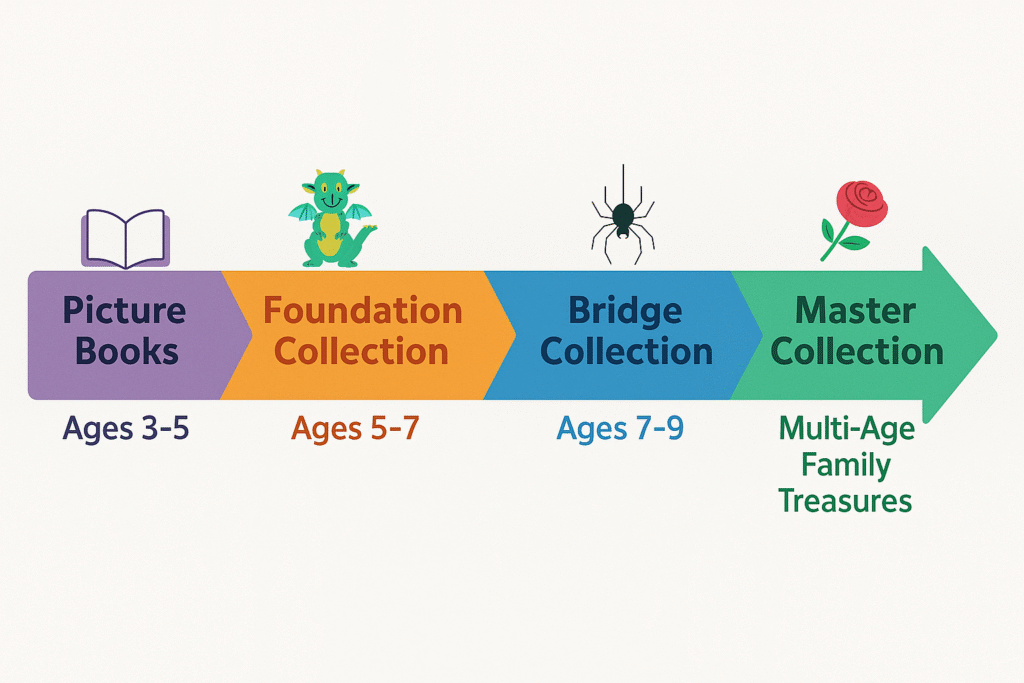
This carefully curated collection acknowledges that seven-to-nine-year-olds are developmentally ready for more substantial stories without sacrificing the engaging qualities that transform reading from obligation into genuine pleasure. These books grow beautifully with children, revealing fresh layers of meaning and understanding with each encounter.
🕷️ Charlotte’s Web by E.B. White
The extraordinary friendship between Wilbur the pig and Charlotte the spider teaches children profound lessons about loyalty, sacrifice, and life’s natural cycles in ways that resonate across all ages and backgrounds. Fair warning—keep tissues readily available for the emotionally powerful ending that moves adults as deeply as children. This timeless masterpiece perfectly exemplifies why living books for early readers create such meaningful emotional connections that influence character development and last well into adulthood.
🐭 Stuart Little by E.B. White
A mouse-sized boy navigates human-sized adventures with courage, creativity, and E.B. White’s signature dry humor that delights both children and parents. The episodic chapter structure works brilliantly for families managing shorter attention spans or frequently interrupted schedules, proving that truly effective children’s books adapt gracefully to real family constraints and varying circumstances.
👧 Pippi Longstocking by Astrid Lindgren
The strongest girl in the world lives independently, makes pancakes on her kitchen floor, and transforms ordinary situations into extraordinary adventures that celebrate freedom, imagination, and unconventional problem-solving. This represents pure childhood wish-fulfillment that embodies the rebellious spirit of creative thinking, making it one of the most empowering books that encourages children to approach challenges with confidence and originality.
🦗 The Cricket in Times Square by George Selden
A musical cricket from rural Connecticut discovers himself in bustling New York’s subway system, forming unlikely but lasting friendships with a streetwise mouse, sophisticated cat, and lonely boy. Music, friendship, and urban adventure combine in one delightful literary package that demonstrates how quality books can introduce complex metropolitan settings in completely accessible ways that expand children’s understanding of diverse environments and lifestyles.
💧 A Drop of Water by Walter Wick
Stunning macro photography reveals water’s hidden world through carefully designed experiments and close-up images that feel absolutely magical to young observers. Science presented as visual art—children consistently beg to recreate the experiments after experiencing this unique addition to any living books for early readers collection that proves learning can be simultaneously educational and breathtakingly beautiful.
🦌 The Burgess Animal Book for Children by Thornton Burgess
Continue learning about animal behavior through Peter Rabbit’s ongoing adventures in the mysterious Green Forest. Each chapter introduces different animal species with fascinating behavioral facts woven seamlessly into engaging story, perfectly demonstrating why living books for early readers excel at building comprehensive knowledge naturally through compelling narrative context.
Master Collection: Multi-Age Family Treasures
These exceptional books work magnificently for mixed-age families where siblings span multiple developmental levels. They possess enough sophistication to engage older children, sufficient accessibility for younger ones, and enough depth that adults discover new meanings and applications with each reading session—the defining characteristic of truly great literature that transcends age boundaries.
The genius of this premium collection lies in their remarkable ability to grow alongside families over many years. A five-year-old focuses primarily on exciting adventures, an eight-year-old connects deeply with character development and relationships, while a ten-year-old begins appreciating sophisticated themes, literary devices, and historical contexts. One carefully chosen book serves multiple children at distinctly different developmental stages.

🌹 The Secret Garden by Frances Hodgson Burnett
Spoiled, sickly Mary Lennox undergoes complete transformation as she helps restore both a neglected garden and broken relationships through patience, hard work, and growing compassion. The interwoven themes of personal growth, environmental stewardship, and healing power of nature speak meaningfully to every age level, establishing this as a cornerstone selection that matures beautifully with children rather than being quickly outgrown and abandoned.
🐸 The Wind in the Willows by Kenneth Grahame
Mole, Ratty, Badger, and the irrepressible Toad navigate riverside adventures that offer cozy escapism combined with surprisingly sophisticated language that naturally enriches vocabulary without feeling forced or academic. The atmospheric Wild Wood chapters add perfectly calibrated suspense for older listeners while remaining entirely appropriate for younger children who benefit from gentle adventure balanced with comforting familiarity.
🏝️ Island of the Blue Dolphins by Scott O’Dell
Karana’s remarkable eighteen-year survival story teaches resilience, resourcefulness, and profound respect for natural environments through compelling first-person narrative. Based on documented historical events, it demonstrates what determined humans can accomplish when facing seemingly impossible circumstances—a powerful example of how quality literature can address serious themes appropriately without overwhelming or frightening young listeners who benefit from examples of human strength and ingenuity.
🏘️ Little House in the Big Woods by Laura Ingalls Wilder
Pioneer family life viewed through young Laura’s observant eyes makes American frontier history feel immediate and personally relevant rather than distant and abstract. Children consistently love the detailed descriptions of seasonal rhythms, daily work, and strong family traditions that create security and meaning. This beloved classic demonstrates perfectly why historical literature remains engaging and relevant across multiple generations of readers who connect with universal themes of family, home, and belonging.
🐕 Because of Winn-Dixie by Kate DiCamillo
Ten-year-old Opal and her rescued dog gradually bring together an entire small-town community through friendship, acceptance, storytelling, and the healing power of genuine relationships. A thoroughly modern classic that provides convincing evidence that quality children’s books aren’t limited to older publications—contemporary authors continue this rich literary tradition of respecting children’s intelligence, emotional capacity, and desire for meaningful stories.
🦀 Pagoo by Holling C. Holling
Follow one hermit crab through his complete life cycle while absorbing detailed information about tidal pool ecosystems, marine biology, and oceanic survival strategies. Science and storytelling blend so seamlessly that readers forget they’re learning comprehensive natural history, perfectly exemplifying the integrated educational approach that makes quality literature so remarkably effective without ever feeling academic or forced.
🐢 Minn of the Mississippi by Holling C. Holling
A snapping turtle’s epic journey down America’s greatest river teaches geography, regional history, and ecological relationships through adventure and Holling’s signature detailed illustrations. Detailed maps and scientific drawings create an immersive experience that feels like an engaging nature documentary in book form—ideal for visual learners discovering how quality books successfully combine multiple learning modalities.
The Complete Implementation System
Successfully incorporating living books for early readers into your family’s routine requires much more than simply purchasing quality literature. Even the most comprehensive collection remains worthless if those carefully chosen titles gather dust on shelves while children gravitate toward screens and less enriching entertainment options.
This proven organizational system has completely transformed reading time for hundreds of families committed to using great books effectively. Instead of random book selection that creates chaos, overwhelming choices, or neglected literature, you’ll establish sustainable structure without suffocating rigidity that destroys the natural joy of discovery.
🎯 Common Problems This System Solves:
- Books started but never finished
- Overwhelming choice paralysis
- Same favorites read repeatedly while others sit ignored
- Inconsistent reading schedules that fizzle out
- Multiple children at different levels needing different approaches
📖 Download Your Free Reading Implementation Guide
Get the complete book lists, rotation system, and printable trackers that make living books simple (and fun) for your family.
👉 Download the Free Guide (PDF)The Proven 3-Track Rotation System

This organizational method prevents the predictable pitfalls that derail even well-intentioned families. When parents attempt to use quality literature without systematic planning, they typically bounce randomly between books, never completing anything satisfying, or get trapped reading identical favorites repeatedly while other excellent books remain permanently ignored.
📚 Science & Nature Track
The Burgess Bird Book, The Moon Book, A Drop of Water, Pagoo
Focus: Observation skills, scientific thinking, natural world connections
📚 History & Heritage Track
Little House in the Big Woods, Minn of the Mississippi, The Secret Garden
Focus: Cultural roots, historical understanding, human story connections
📚 Adventure & Imagination Track
Charlotte’s Web, My Father’s Dragon, Stuart Little, Mr. Popper’s Penguins
Focus: Creativity, emotional intelligence, character development
Each carefully planned track contains 3-4 strategically chosen books, ensuring families spend 3-4 focused weeks exploring one track before rotating naturally to the next. This prevents “science overload” or “too much fantasy” while guaranteeing children receive balanced exposure to different genres and subjects without forced variety that feels artificial or rushed.
The brilliance of this system lies in its combination of structure and flexibility that accommodates real family life. When reading time becomes integrated into evening routines, consider incorporating it with other family game night activities for comprehensive family bonding that strengthens relationships while building positive associations with learning.
Practical Weekly Implementation That Actually Works Long-Term
Monday: Science/Nature track exploration
Wednesday: History/Heritage track journey
Friday: Adventure/Imagination track discovery
Weekend: Complete freedom (repeat beloved favorites or include picture books for younger siblings)
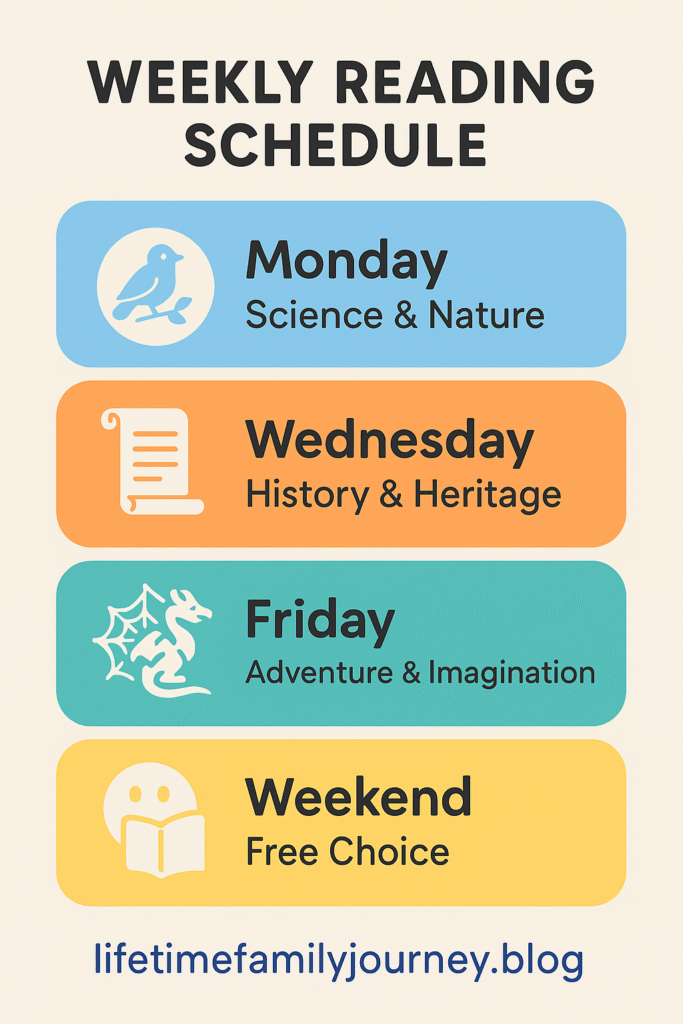
This carefully balanced rhythm provides sufficient structure to ensure consistent progress while maintaining flexibility for real life’s inevitable interruptions and schedule changes. Some weeks you’ll successfully read daily. Other weeks you’ll manage only twice. Both approaches represent complete success when implementing quality literature authentically within the beautiful chaos of actual family life.
📋 Success Tracking Made Simple:
- Mark completed chapters on your printable tracker
- Note favorite quotes or memorable moments
- Record which books spark the most discussion
- Track which genres individual children prefer
- Celebrate finished books with special recognition
The crucial insight most families miss: sustainable consistency matters infinitely more than rigid perfection. A realistic routine with great books consistently beats ambitious plans that flame out after two weeks when normal life disrupts idealistic schedules.
Practical Tips for Real Families
⏰ Keep reading sessions appropriately short for sustained success. Start with 10-15 minutes and adjust based on attention spans, energy levels, and genuine interest. Always better to end while children want more than to push past natural limits and create negative associations with reading time.
📖 Master the art of strategic cliffhangers. End chapters mid-action when something exciting is about to happen. Children will actually request reading time instead of avoiding or dreading it when anticipation builds naturally.
🎨 Allow creative expression during listening time. Hands busy, minds fully engaged. My daughters consistently create elaborate illustrated encyclopedias during our Burgess nature books sessions. For creative reading space ideas, explore these budget-friendly DIY kids room ideas that won’t break your family budget.
🎧 Embrace audiobooks as completely legitimate literature. Skilled narrators bring characters to vibrant life in ways that even excellent parents sometimes cannot match. Don’t allow perfectionist homeschool guilt to rob your family of this powerful educational tool.
🏡 Create inviting reading environments. While discussing healthy reading spaces, these safe cleaning products help maintain chemical-free areas where families can gather comfortably for extended reading sessions.

Warning: The Burgess Bird Book may permanently transform your children into backyard bird identification experts who confidently correct adults about robin migration patterns, nesting behaviors, and seasonal feeding habits. Consider yourself appropriately warned about this delightful side effect.
Frequently Asked Questions About Living Books for Early Readers
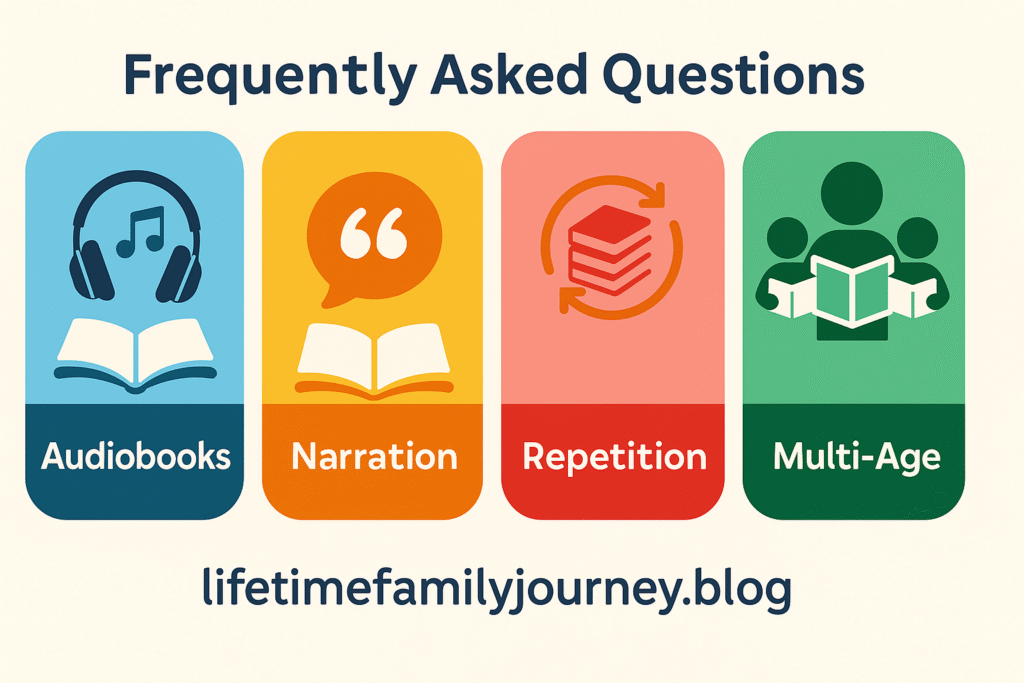
What’s the fundamental difference between living books for early readers and traditional textbooks?
Quality literature is crafted by passionate authors who genuinely love their subjects and write with authentic enthusiasm and expertise. They use rich, natural language, tell compelling complete stories, and connect ideas organically through narrative flow. Traditional textbooks present isolated facts in bite-sized chunks designed for easy testing but typically lack the narrative coherence that makes information truly memorable and meaningful.
According to Charlotte Mason philosophy, great books create lasting intellectual engagement while textbooks often result in temporary memorization followed by rapid forgetting.
How long should reading sessions be when using quality literature effectively?
Begin with 10-15 minutes and adjust based on individual attention spans, energy levels, and genuine interest in the material. Always prioritize ending while children want more rather than pushing past natural limits and creating negative associations with reading time. Some days you’ll successfully read one page, other days you’ll complete entire chapters—both scenarios represent genuine victories when building your homeschool book list with excellent books.
Do audiobooks legitimately count as quality literature?

Absolutely! Professional narrators can bring characters to vibrant life and help children access books that exceed their independent reading levels by several years. The listening experience doesn’t diminish educational value or literary appreciation. Many families discover that audiobooks actually open doors to more sophisticated literature than children could handle independently, expanding their literary horizons significantly.
What should I do if my child wants to hear the same book repeatedly?
Embrace repetition enthusiastically! Repeated readings deepen understanding, build familiarity with complex language patterns, and indicate your child has found something genuinely meaningful in that particular story. Continue offering fresh options from your collection, but never force artificial variety if children are absorbed in beloved stories. These read aloud books for families work most effectively when children feel authentic ownership over their literary experiences and choices.
How can I adapt quality literature to work effectively with multiple ages simultaneously?
Select books from the “Multi-Age Family Treasures” section that naturally accommodate your age range effectively. Younger children follow exciting plots and absorb sophisticated language patterns, while older children connect with deeper character development and thematic content. Everyone benefits from exposure to rich vocabulary and compelling storytelling. If you’re homeschooling multiple kids with varying needs, great books can become an absolute lifesaver for mixed-age learning that keeps everyone engaged and progressing.
The Life-Changing Magic of Great Stories
Living books for early readers represent far more than educational tools—they create lasting family connections that strengthen bonds across generations. When my family gathers for our cherished story time, we’re not simply reading about Charlotte’s web or Elmer’s dragon rescue mission. We’re sharing wonder, asking deep questions, and building precious memories around stories that matter profoundly to each family member.
The systematic rotation keeps experiences fresh and prevents reader burnout, the carefully planned variety ensures everyone discovers something personally meaningful, and the manageable short sessions make this approach sustainable for real families managing genuine schedules and realistic limitations. For additional ideas about building healthy family routines that actually persist long-term, I’ve developed practical strategies that work effectively even amid the beautiful chaos of large family life.
🌟 Start small but dream big. Choose one appealing book from our tested collection that genuinely interests you personally. Read it consistently to your children for two full weeks. Watch carefully as their eyes light up when fictional characters become treasured friends and abstract facts transform into engaging adventures. That magical moment reveals exactly why families have been choosing quality literature for well over a century.
📖 Create meaningful traditions that last generations. Some of our family’s most treasured memories center around specific books and reading experiences. The emotional evening when we all cried together over Charlotte’s sacrificial death. The excited morning when my youngest announced his determination to rescue dragons exactly like brave Elmer. The peaceful afternoon spent in our backyard identifying bird species after reading Burgess nature stories together. These shared moments become the foundational stones of childhood memories that shape character and family identity.
🎯 Focus on relationships over rigid perfection. The ultimate goal isn’t checking books off predetermined lists or meeting arbitrary reading standards imposed by others. True success means raising children who genuinely love stories, think deeply about important ideas, and view books as treasured friends rather than tedious assignments. Quality literature consistently excels at creating these positive associations because it respects children’s natural intelligence while meeting them exactly where they are developmentally.
What books have transformed your family’s reading experiences? Share your discoveries in the comments—I’m always excited to find our next great adventure to add to our growing collection!
Download Your Free Implementation Guide
I’ve created a comprehensive printable resource that includes all 20 book recommendations organized by age groups and tracks, plus a simple rotation grid you can check off as your family progresses through this literary adventure.
📋 What’s included in your free guide:
- Complete book lists organized by developmental age groups
- 3-track rotation system with suggested weekly schedules
- Progress checkboxes for tracking completed chapters and books
- Space for recording favorite quotes and memorable family moments
- Dad Notes with humor, encouragement, and realistic expectations
- Troubleshooting tips for common implementation challenges
Want to put this into action? Download the Free Reading Implementation Guide here.
Print it, attach it to your refrigerator, and watch those carefully chosen books actually get read consistently instead of being admired from a distance while gathering dust.

Explore More from Our Family of Blogs
Mountains Will Move
Faith-based encouragement for everyday families.
Everyday Exposed
No-filter truth hub for critical thinking and clarity.
Thank you for being part of the community. God Bless you and your family.
